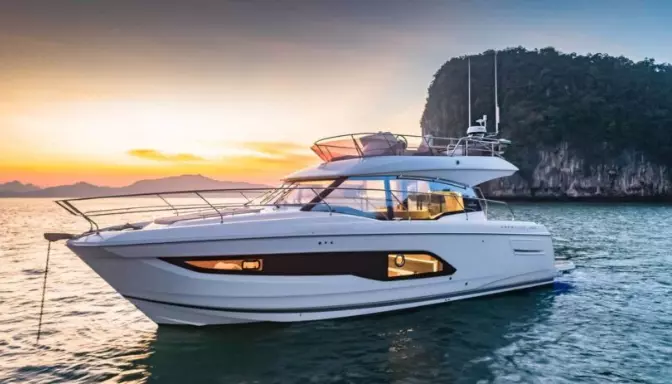Diksia.com - The boating industry experienced a remarkable boom during the COVID-19 pandemic, as people sought outdoor recreational activities that allowed for social distancing. This led to a surge in demand and a rise in prices for both new and used boats from 2020 to 2022. However, as the pandemic subsides and the global economy recovers, many potential boat buyers wonder: are yacht prices falling in 2023?
The answer is not so simple, as there are several factors that influence the price of yachts, such as supply chain issues, inflation, interest rates, consumer demand, and oil prices. In this article, we will analyze each of these factors and provide a forecast for the boating market in 2023 and beyond.
Supply Chain Issues
One of the main reasons why yacht prices increased in the past two years was the disruption of the global supply chain caused by the pandemic. Shortages of materials like fiberglass, resin, steel, aluminum, and electronics, as well as labor shortages, hampered the production of new boats and increased the costs for manufacturers. As a result, many boat builders had to raise their prices and extend their delivery times, creating a backlog of orders and a scarcity of inventory.
According to the National Marine Manufacturers Association (NMMA), new boat sales in the US declined by 14% in 2022 compared to 2021, mainly due to supply constraints1. However, the NMMA also reported that the supply chain issues have started to ease in 2023, as manufacturers have adapted to the new challenges and increased their production capacity2. This means that the availability of new boats will improve in 2023, which could lead to a moderation of price growth or even a slight decrease in some segments.
Inflation
Another factor that affects yacht prices is inflation, which is the general increase in the prices of goods and services over time. Inflation reduces the purchasing power of money and makes everything more expensive, including boats. Inflation can be caused by various factors, such as excessive money supply, rising demand, higher production costs, or external shocks.
The US experienced a spike in inflation in 2021, reaching a 40-year high of 6.8% in November3. This was mainly driven by the rebound in consumer demand after the pandemic, the stimulus measures by the government, and the supply chain bottlenecks that created shortages and higher costs for many goods. Inflation remained high in 2022, averaging 5.4% for the year4.
However, many economists expect inflation to moderate in 2023, as the supply chain issues are resolved, the stimulus effects fade, and the Federal Reserve raises interest rates to curb inflationary pressures. The latest projections by the Federal Reserve indicate that inflation will fall to 2.6% in 2023 and 2.2% in 2024. This could have a positive impact on yacht prices, as lower inflation means lower costs for boat manufacturers and lower interest rates for boat buyers.
Interest Rates
Interest rates are another important factor that influences yacht prices, as they affect the cost of borrowing money to finance a boat purchase. Interest rates are determined by the supply and demand of money in the economy, as well as by the monetary policy of the central bank. When interest rates are low, borrowing money is cheaper and more attractive, which stimulates demand and increases prices. When interest rates are high, borrowing money is more expensive and less appealing, which dampens demand and lowers prices.
The Federal Reserve, which is the central bank of the US, has kept interest rates near zero since March 2020, as part of its response to the pandemic. This has helped to support the economic recovery and the boating industry, as low interest rates made boat financing more affordable and accessible for many buyers. However, the Federal Reserve has also signaled that it will start to raise interest rates in 2023, as inflation remains above its target of 2% and the labor market improves.
The Federal Reserve’s latest projections indicate that the federal funds rate, which is the interest rate that banks charge each other for overnight loans, will increase to 0.9% by the end of 2023 and to 1.6% by the end of 2024. This means that boat financing will become more expensive and less attractive in the next two years, which could reduce the demand and the prices for yachts.
Consumer Demand
Consumer demand is another key factor that determines yacht prices, as it reflects the willingness and ability of buyers to purchase boats. Consumer demand is influenced by various factors, such as income, preferences, expectations, confidence, and substitutes. When consumer demand is high, boat sales increase and prices rise. When consumer demand is low, boat sales decrease and prices fall.
The boating industry saw a surge in consumer demand during the pandemic, as people sought outdoor recreational activities that allowed for social distancing. According to the NMMA, new boat sales in the US reached a 13-year high in 2020, with 318,000 units sold, and remained strong in 2021, with 307,000 units sold. This increased the number of boat owners in the US, which reached a record of 12.7 million households in 2021.
However, consumer demand may moderate in 2023, as the pandemic subsides and other recreational options become available. Moreover, consumer demand may be affected by the economic uncertainty, the high inflation, and the rising interest rates, which could reduce the income and confidence of potential buyers. Still, consumer demand may remain relatively high, as new boat owners enter the market and existing boat owners upgrade or trade their boats.
Oil Prices
Oil prices are another factor that affects yacht prices, as they impact the production costs and the operating costs of boats. Oil is a key component in fiberglass, which is the most common material used to build boats. Oil is also the main fuel used to power boats, especially yachts. Therefore, when oil prices are high, boat production costs and boat operating costs increase, which reduces the profitability and the affordability of boats. When oil prices are low, boat production costs and boat operating costs decrease, which increases the profitability and the affordability of boats.
Oil prices fluctuated significantly in the past two years, due to the pandemic, the supply and demand dynamics, and the geopolitical tensions. Oil prices collapsed in 2020, reaching a negative value in April, as the pandemic reduced the global demand for oil and created a glut in the market. Oil prices recovered in 2021, reaching a seven-year high of $85 per barrel in October, as the global demand for oil rebounded and the supply was constrained by the OPEC+ alliance and the US shale industry. Oil prices remained high in 2022, averaging $75 per barrel for the year, as the demand for oil continued to grow and the supply was disrupted by the war between Russia and Ukraine.
However, oil prices may decline in 2023, as the war between Russia and Ukraine ends, the OPEC+ alliance increases its production, and the US shale industry resumes its activity. The latest projections by the US Energy Information Administration (EIA) indicate that oil prices will average $68 per barrel in 2023 and $65 per barrel in 2024. This could have a positive impact on yacht prices, as lower oil prices mean lower production costs and lower operating costs for boats.
Conclusion
In conclusion, yacht prices are unlikely to fall significantly in 2023, as there are several factors that support the high prices of boats, such as supply chain issues, inflation, interest rates, consumer demand, and oil prices. However, yacht prices may moderate or decrease slightly in some segments, as the supply chain issues ease, the inflation moderates, the interest rates rise, the consumer demand moderates, and the oil prices decline. Therefore, the best time to buy a yacht depends on the specific type, size, and model of the boat, as well as on the personal preferences and budget of the buyer.






